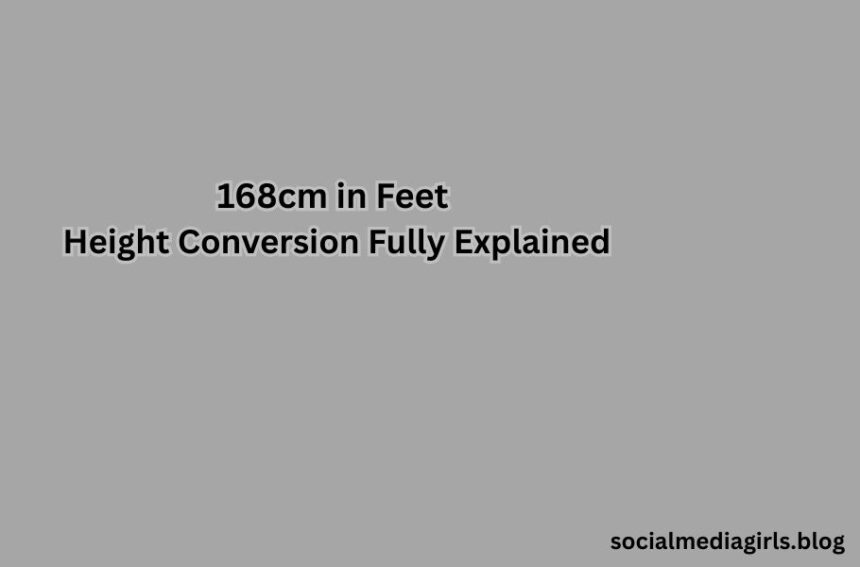Height conversion might seem like a trivial thing at first glance, but it’s surprisingly essential in many aspects of our daily lives. Whether you’re trying to understand someone’s height from another country, shopping online for clothes that fit properly, or just filling out a medical or immigration form, knowing how to convert between centimeters and feet can save time and avoid confusion. The metric and imperial systems are both widely used around the world, but unfortunately, they don’t always communicate well with each other. That’s why knowing how to switch from one to the other—like turning 168cm in feet—can be extremely useful. Especially in a globalized world, being fluent in both systems is almost like being bilingual.
What exactly is 168cm in feet?
Centimeters, abbreviated as 168cm in feet are part of the metric system, which is widely used in Europe, Asia, and many other regions. When someone says they are 168cm tall, they are referring to the distance from the base of their feet to the top of their head, measured using a system that works in tens, hundreds, and thousands. To give you a quick picture: one meter is 100 centimeters, and 168cm is 1.68 meters. This height is fairly average and commonly seen in adults, particularly women. In some countries, this is even considered tall for a woman and slightly below average for a man. But to truly grasp how tall this is, especially for those familiar with the imperial system, converting to feet and inches is the easiest solution.
How to Convert 168cm to Feet and Inches
The standard method for converting centimeters to feet is by using a conversion factor. Since 1 inch equals 2.54 centimeters and 1 foot contains 12 inches, you can follow a two-step process. First, divide 168cm by 2.54 to convert it to inches, which gives you approximately 66.14 inches. Then divide 66.14 by 12, and you’ll get approximately 5.511 feet. This means 168 centimeters is roughly 5 feet 6 inches tall. The .511 is the decimal representing the remaining inches, which equals about 6.14 inches. So, if you prefer the imperial format, you can say a person who is 168 cm tall stands around 5’6″. This precise conversion allows people in the United States, UK, and other imperial-based systems to understand height more intuitively.
Real-World Examples of 168cm in Height
Understanding 168cm in feet in theory is one thing, but visualizing it in the real world helps it stick. Imagine standing next to a kitchen counter—those are usually about 3 feet tall. A person who is 168 cm tall would be more than 2 feet taller than that counter. Think of the average height of a woman in many Western countries—between 5’4” and 5’6”. So, a 168 cm person would generally fit into that average. Compare that to celebrities: actresses like Natalie Portman and Scarlett Johansson are around this height, as are many professional female athletes in tennis or gymnastics. In crowded spaces like buses or elevators, someone at 168 cm wouldn’t feel overly tall or short—just comfortably in the middle.
How Does 168cm Rank Globally?
Height perceptions differ wildly around the world. In countries like the Netherlands, where the average male height exceeds 6 feet (183 cm), someone who stands at 168 cm might be considered a bit short, especially for a man. However, in many parts of Asia and South America, 168 cm is average or even on the taller side. For instance, the average male height in India is around 167 cm, while the average for women is about 152 cm. That puts a 168 cm person above average in many regions. This shows how height is not absolute—it depends on cultural, environmental, and genetic factors. What seems short in one country may be seen as tall in another.
Is 168cm in feet a Good Height for Women?
Absolutely. In fact, in fashion and modeling industries, 168 cm is often listed as the ideal minimum height for runway or editorial models, especially in Asia. This height offers a slim and elongated silhouette that photographs well and fits standard clothing samples designed for taller frames. It also strikes a good balance between height and everyday functionality. Most women at this height find it easy to buy off-the-rack clothes, reach overhead shelves without a stool, and enjoy the perks of being “tall enough” without standing out too much in a crowd. Socially and practically, 168 cm is often seen as graceful, elegant, and balanced.
How is 168cm viewed for Men?
For men, 168 cm can be seen differently depending on the culture. In many Western countries, it falls slightly below the male average, which typically ranges between 175 cm to 180 cm. However, it’s by no means considered too short. Many male celebrities and public figures are around this height or shorter and still enjoy successful careers. Being 168 cm might mean occasionally needing to hem pants or choosing more tailored fits, but it doesn’t hinder daily life. Confidence, presence, and personality often outweigh physical height, especially when people carry themselves well. Besides, in sports like boxing, gymnastics, or motorsport, being a bit shorter can even be an advantage.
Why the Measurement Systems Confuse So Many
One of the main reasons height conversions cause so much confusion is because people are taught different systems based on their country. The imperial system uses feet and inches and is still common in the U.S., while most of the rest of the world has moved to the metric system for simplicity and consistency. The imperial system isn’t base-ten, which means the math is a bit trickier. That’s why a simple conversion like 168 cm into feet requires two calculations—first into inches, then into feet. It’s no wonder people look for conversion apps or charts when they need a fast answer.
Using Digital Tools for Easy Conversion
Thankfully, we live in an era where technology can handle these little nuisances for us. Just type “168 cm in feet” into Google, and you’ll get an instant answer. There are also plenty of dedicated mobile apps like “Unit Converter” or “ConvertPad” that help convert length, weight, temperature, and more. Some smartwatches and health trackers also offer built-in settings that let users switch between metric and imperial for height and weight data. These tools are especially helpful when traveling, shopping internationally, or filling out applications that ask for height in feet and inches.
168cm in Professional and Personal Contexts
Height can play a surprisingly significant role in both professional and personal contexts. For example, in modeling, as mentioned earlier, 168cm in feet is often an ideal height for women. In aviation, flight attendants usually have to meet a certain height to safely reach overhead compartments, and 168 cm typically qualifies. In the dating world, height often comes up as a topic, though preferences vary widely. Professionally, some employers have hidden biases based on perceived height and presence, even though it’s rarely a formal requirement. But at 168 cm, most people find they’re rarely too tall or too short for any situation.
Why it’s Okay to Embrace Your Height
At the end of the day, height is just one small piece of who you are. Whether you’re 168 cm or 198 cm, it doesn’t define your worth, capability, or character. If you’re 168 cm, you’re part of a very large group of people who fall comfortably within global averages. And knowing how to express that height in another system just makes you a bit more prepared and worldly. Plus, people don’t usually remember how tall you are—but they do remember how you made them feel.
FAQs About 168cm in feet
What is 168 cm exactly in feet and inches?
168 centimeters is equal to approximately 5 feet 6 inches.
Is 168 cm short for a man?
It’s slightly below average in some countries, but very normal or even above average in others. It’s all relative to location and perspective.
Is 168 cm tall for a woman?
Yes, in many countries, 168 cm is above the average female height and is often considered tall and elegant.
How do I convert cm to feet manually?
Divide the number of centimeters by 2.54 to get inches, then divide that by 12 to get feet.
Why are there two systems of measurement?
The imperial system is still used in countries like the U.S. due to tradition, while the metric system has been adopted globally for its simplicity.
Conclusion
Converting 168cm in feet may seem like a small task, but it opens up a whole conversation about global standards, culture, and identity. At approximately 5 feet 6 inches, 168 cm fits neatly into the middle of the world’s height spectrum—neither too tall nor too short. It’s a height that works well in most professional and personal settings and can be considered ideal in many industries, especially for women. With a bit of math or a quick online search, anyone can convert height measurements between systems. In the end, height is just a number—it’s who you are and how you carry yourself that really counts.





h43di5